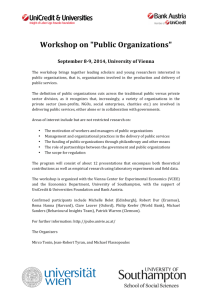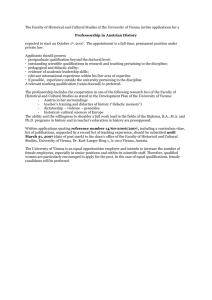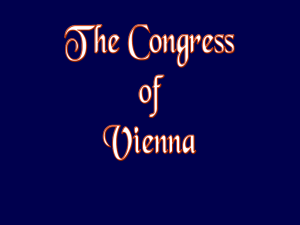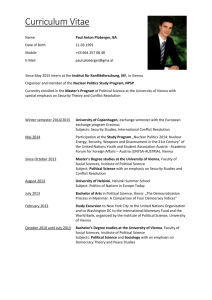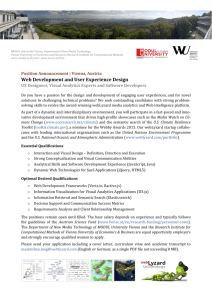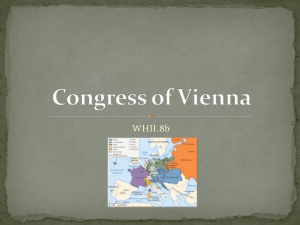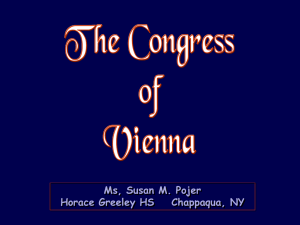i VIENNA SUD: by NEW
advertisement
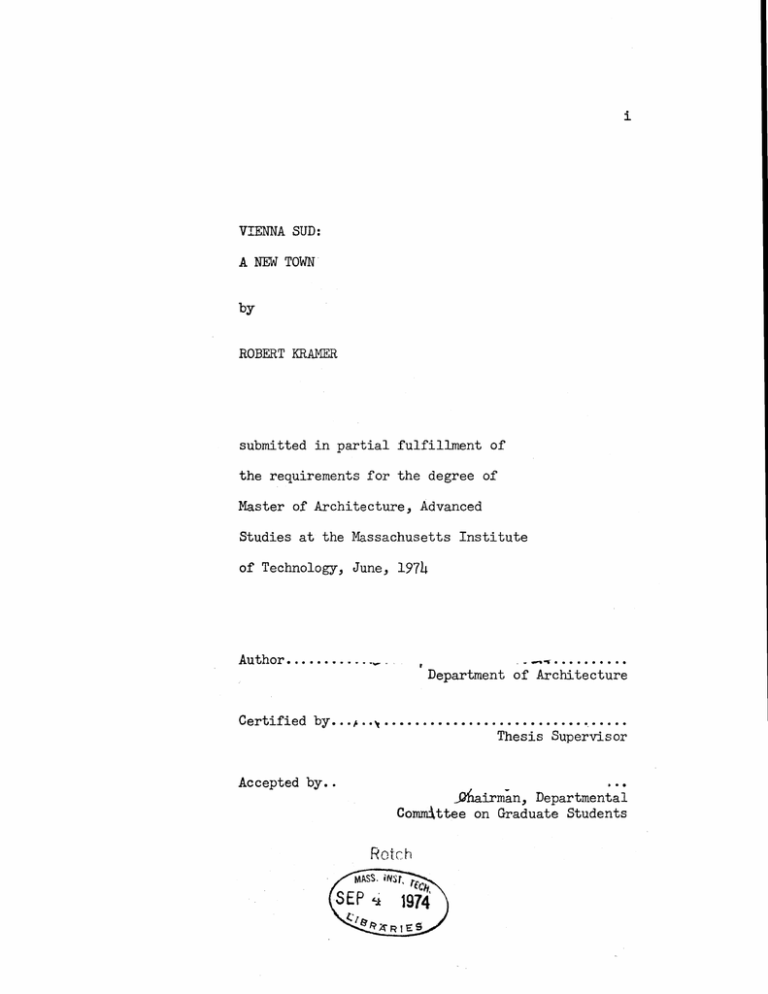
i VIENNA SUD: A NEW TOWN by ROBERT KRAMER submitted in partial fulfillment of the requirements for the degree of Master of Architecture, Advanced Studies at the Massachusetts Institute of Technology, June, 1974 Author........... Department of Architecture Certified by...A..y............................... Thesis Supervisor Accepted by.. Afiairm'an, Departmental Committee on Graduate Students Rotch ii Dean William Porter School of Architecture and Planning Massachusetts Institute of Technology April 1974 Dear Dean Porter, In partial fulfillment of the requirements for the degree of Master of Architecture, Advanced Studies, I hereby submit this thesis entitled: Vienna Sud: A New Town. Repp4ectfAlly, Robert Kramer iii ABSTRACT This thesis consists of a design and development strategy for a new urban area to be created on the southern edge of the city of Vienna. The content and execution of this thesis closely follows the criteria and general conditions of the International Town Planning Competition (VIENNA SUD), organized by the Vienna City Council in February 1970. TABLE OF CONTENTS ABSTRACT....................................................iii Map Showing Site of Vienna Sud.... .... .............. .......... v The Problem..................................................1 Policy Statement.................. ............................ 1 Contingency Planning and Design... ....... . .................... 2 Formal Principles for Contingency Planning.. .. .. .. .. .. .. . .. e. . 3 Strategy for Incremental Growth............. ................. 5 Indigenous Development Zones ................ .......... ....... Bibliography................................ ................................ 8 13 Documentation of Submitted Competition Material.. .... . .. .....-- 114 iv "Do you think one man or even a team of men can design a city?" Imre Halasz in conversation "According to the legend, the marabout who founded El-Hamel at the end of the sixteenth century stopped to spend the night near a spring and planted his walking stick in the ground. The next morning, when he went for it to resume his journey, he found that buds had sprouted on it. He considered this a sign of God's will and settled in that place." Rene Basset in Revue des Traditions Populaires, XXII, 1907, p. 287 twl A Z. ZT,&DOM iD--'; G - %O 54 a' - V'S -r"M -~ ', lt ,. rv '# ,x,%N: *2 ~ ~~~ ~ %\. 5 i, c~hr ?I OR po Ell-4 -r,;'4Q NIP k 0r IIII~~~IAER ' zIII__ _. ldI11 os "'T"(~ 'M - -.- 7-Ins 'f 1 I-- -.-4 / WHOM .,k I - ~ l -" I - VIENNA SUD The Problem: 1 The primary cause for the development of the new district was the need to meet the demand for new living units for people packed into Vienna's over-congested and physically deteriorating city core. In 1970 Vienna was also in dire need of space for the establishment of new manufacturing enterprises and the relocation of existing industries that were housed in unfavorable conditions. Population growth, although important, was not considered the major cause for new development. Policy Statement: The new district was to provide a balanced environmental organization for both living and working, including all supportive amenities which would naturally accrue to each of these sectors. The district itself, however, was not thought of as an independent satellite or dormatory town, but as an integral development, part of the city and metropolitan region of Vienna. 2 The new district would offer 25,000 to 30,000 persons on site employment with a wide range of employment opportunities, thus relieving the residents of the need to commute to other sectors of the city. Another factor of consideration was the generative effect that the metropolitan living habits of the residents would have upon the rest of the city. Presumably, conditions would be deemed optimal, if the number of employment opportunities were to correspond to approximately lation. ho% of the local popu- This meant that one third or half of the available jobs in the area would be filled by people living there, the rest by commuters. The new development warranted the provision of a special center incorporating shopping precincts and central public service facilities. Contingency Planning and Design for Vienna Sud: The proposal for Vienna Sud consists of a planning and design strategy for physical development. The form the development takes at any time is contingent upon the application of formal principles and the strategies of evolving developmental forces. form the development takes through time is The the 3 history of the contingent applications of these strategies and principles. By developmental forces we mean the ways in which public agencies, the private residential, commercial and industrial developers, and individuals and groups in the population act upon their environment. For the trans- portation authority it is how they build subways and highways; for the private developer it is the type, scale, location and intensity of development he is willing to undertake; for individuals and groups it is what and where they choose to buy or build. Formal Principles for Contingency Planning: The proposal for Vienna Sud also consists of the prediction for possible futures, developed in accordance with principles which will guide its evolution. Much of its physical structure can be predetermined by transportation networks, zoning for industry, commerce, community and recreation facilities and landscape features of lakes, berms and trees; however, special zones will be created so that much of its real, experiental character can be determined by the will and spirit of the future inhabitants. Such areas will be known as Indigenous Development Zones. Their character will be strongly impressed 4 on the landscape and in turn the particular features of the growing fabric of Vienna South will affect each zone. Hence the form of Vienna South will respond in a way contingent upon the expressive characteristics of each of its components and each component will grow in a way contingent upon the development forces in Vienna South. Each element of the plan is the resultant form of the dynamic interaction of two processes--the pattern generated by each element (e.g. each community whole, the center/commercial area/the industrial network) and the constraining conditions arising from the context of Vienna South in which each element finds itself. The external processes impinging on each element and the counter-processes each element places on the whole fabric will stem from historical, social, political, economic and physical requirements. Normally development takes place by imposing the desires of a limited group or individual on an area; such developments are often simplistic, express only singular needs and lack the richness of growth that takes place over time that gives full expression to the will of an indigenous population and its myriad and complex needs. The principle of contingent development specifically calls for development to take place contingent upon the many developmental forces including--most significantly--the free expression for the will of its concerned inhabitants to evolve in a context where a wide range of human needs may interact. Strategy for Incremental Growth: The planning and design strategy associates proposed natural features--berms, lakes which result from making the berms, and the trees and ground cover-with the activities and facilities of man. The association is intended to give autonomy to each development unit while still maintaining necessary and desired interconnections. Conditions of growth are somewhat unpredictable: locally, the commercial, residential and industrial viability of Vienna South; and globally, the state of the economy and the degree of social consensus behind government sponsored development. The planning and design would give visual and 6 functional form to this unpredictable process, responding tactically by scaling the size of development parcel which was economically and socially viable at the time. Thus, the strategy is not a master plan to be followed rigidly but a measured response to particular economic and social conditions. Initially, the development area is seen as a great park space in and through which the fabric of the new town gradually finds itself, unfolding in a sensitive measured response to the growing formal surface character of the site. The preparation of the site as a great park could precede or be simul- taneous to the execution of the first stage development of the major center. In any case, the early improvements to the site, providing leisure and recreational facilities through the creation of an open green space linking up with the city's existing park system (see plan Dl), would give immediate gratification to the citizens of Vienna and would insure, to some degree, the success in the early stage of the project's development; should, for unforseeable reasons, the project fail or be abandoned, Vienna would still have the benefit of a 7 major public amenity. The formal layout of the park in the first stage would be based upon the "Idealized Future" stage III plan--the creation of secondary roads, waterways, orchards and earthsurface modifications (landscaping and earth berms defining future Indigenous Development Zone sites) would "sketch out", early in the project's development life, the site's future character and potential richness. As stated before, growth conditions for the New Development are somewhat unpredictable: locally, the commercial, residential and industrial viability of Vienna South; and globally, the state of the economy and the degree of social consensus behind the government sponsored development. Therefore, we have sought to create a strategy for staging consistent with the contingency nature of the overall plan, as an ongoing, measured response to particular internal and external social and economic conditions. An "idealized future" plan (stage III) has been envisioned, but in no way should it be considered a target to be fully realized as a concretized final objective. Such an assumption on the part of those 8 responsible would impair the free expression and well being of its future inhabitants. The idealized future is seen only as a strawman, showing the potential character the development could take through time, and the maximum degree of development suitable to the site. Indigenous Development Zones: The indigenous development zones would be a part of an overall strategy of development which sees the necessity of creating a viable community out of a series of smaller, independently developed units of growth. These units, during the early stages of development, are able to function as residential neighborhoods without being dependent upon either the rapid or the eventual completion of the rest of the whole community. Thus, in the event that the Vienna South development does not continue to grow according to the original plan, the initial indigenous development zones, in conjunction with the community facilities and supporting activities to which they relate, will still be able to function as desirable residential areas. Additional purposes are also served by the incremental development strategy. By organizing smaller units of development within each stage, a 9 greater flexibility is obtained in permitting several different developers to build at the same time and at varying scales of construction. Flexibility in construction is also achieved because the indigenous development zones can be built separately, according to the demand for a variety of housing types and the degree of resident participation in organizing the The number of development units constructed projects. during a single stage of development might vary from the planned number without necessitating changes in the overall development strategy. If too few develop- ment zones are constructed during the first stages, that fact should not jeopardize the success of the others. This strategy will also give greater identity to each development zone and permit them to be more closely tailored to suit their residents. It may also encourage the formation of local political organizations on this smaller scale to allow resident participation in the direction and control of their local affairs. The Vienna South development agency would designate certain areas for the construction of the development zones within the district. This would be done according to the overall development strategy. The zones might be developed by either the state agency, 10 private speculative builders, resident organizations or non-profit sponsors. The developer would need to form a special development corporation, subject to some regulation and review by the public. The corporation would develop the zone, in accordance with the design and financial controls used by the Vienna South agency, within a specified time. The residents of the development zone might be brought into the corporation in some form in order to allow them a voice in the continuing management and in later redevelopment or intensification of use proposals. The residents could create a parallel organization and take over the functions of the corporation when it dissolves. In effect this organization makes each development zone an independent management unit also, although there should be nothing to prevent two or more of the smaller units from joining together after construction to pool their management resources. Likewise, a developer might be involved in two or more development zones at the same time and continue to build in newly designated zones as Vienna South grows. The conflict between necessary overall planning measures and control of environmental form by the inhabitants of small zones is recognized. Each indigenous development 11 zone will be bounded by a landscape berm at its inception to create a limit of concern for the inhabitants and a buffer to reduce the pressures from external sources, nurturing and focussing the concerns of its in-dwellers. Hence each bounded community becomes a nest in which a sense of place and community expression will continually grow. The form of egth development zone can be different contingent upon the pressures from its place in the fabric of Vienna South. (In place of showing a fully arti- culated, fine grain community structure, we show a schematicized version, reflecting only the gross physical development; to show the actual character of these communities would necessitate taking into account historic, political, social, and economic contingent conditions outlined in the competition program). Several principles for contingent planning apply to and guide the development of these communities, giving them their resultant form: -- Part of each element of the. larger fabric is present in each community. Each community therefore has, to varying degrees, some commercial, some industry, some professional services, some educational insti- tutions. This enables each community to give its inhabitants opportunities to experience a full range 12 of concerns inherent in carrying on human life. --Every element comes together at the community center, heightening the excitement inherently generated when diverse, legitimate concerns meet. --Each community will have its own balance of these elements and should evolve into unique forms, achieving a spirit expressive of the contingent interplay of its singular history, characteristics and place in Vienna South. --The relationships between the elements of each community will follow certain appropriate patterns-e.g., residential areas will be near recreation and commerce, commerce will be near residences and industry. --The boundary of each community will never be complete and will afford appropriate links to interlink the elements of the community to those of Vienna South-- e.g., the light industry of the community will link to the heavier ones of Vienna South, continuous travel will be possible from the park zones of the community to those of Vienna South, the commercial center of the community will occur along the vehicular access to the major commercial center of Vienna South. 13 BIBLIOGRAPHY Competition Program International Town Planning Competition Urban Expansion Vienna Sud 1970, published by Magistrat der Stadt Wien (Vienna City Council), address: Rathaus, A-1082, Vienna, Austria. Minutes of the Jury Published by Magistrat der Stadt Wien. Der Aufbau 10/11 1971, address: Tiefer Graben 7, lOI4 Vienna, Austria. 7 72b Jr.4 /A//10 & 41* A 4 dr .... 3...... . .. ..... ... .. PQ0nuuununn .. a. wonnnm o 4 E7n- 4. - - -. 0 f.d AA isI f Ii Staige Initial scale and! form hypothesis 'j -A I - 44k -- RA AIt Stage I Assuming growth under currently prevai n S A * K! ~ i Stage IIB Assuming modifications in initial scale or form are needed to meet market or socio- political conditions 0
